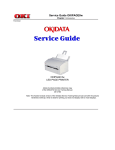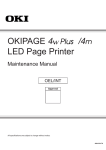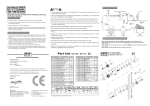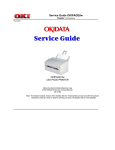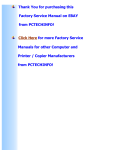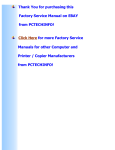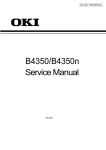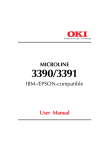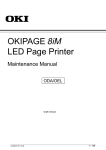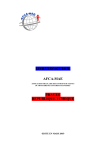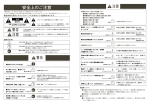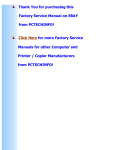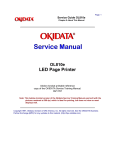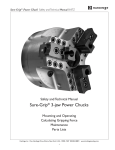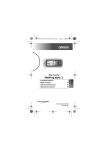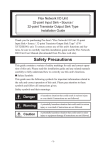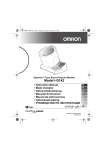Download Service Manual 2
Transcript
¡ OKIPAGE 4w LED Page Printer Maintenance Manual All specifications are subject to change without notice. PREFACE This Maintenance Manual describes the field maintenance methods for LED Page Printers. This manual is written for use by service persons. Please note that you should refer to the Printer Handbook for the handling and operating methods of the equipment. CONTENTS 1. CONFIGURATION ..................................................................................... 1 - 1 1.1 System Configuration ........................................................................ 1 - 1 1.2. Printer Configuration .......................................................................... 1 - 2 1.3 Specification ...................................................................................... 1 - 3 1.4 Safety Standards ............................................................................... 1 - 5 1.4.1 1.4.2 Certification Label .................................................................................... 1 - 5 Warning Label ......................................................................................... 1 - 5 2. OPERATION DESCRIPTION .................................................................... 2.1 Main Control Board ............................................................................ 2.2 Power Supply Unit ............................................................................. 2.3 High-Voltage Power Supply Board .................................................... 2.4 Electro-Photographic Processor ........................................................ 2.5 Electro-Photographic Process ........................................................... 2.5.1 2-1 2-3 2-4 2-4 2-6 2 - 10 Explanation of Each Process Operation .................................................. 2 - 12 2.6 Paper Jam Detection ......................................................................... 2 - 18 2.7 Toner Low Detection.......................................................................... 2 - 20 2.8 Cover Open ....................................................................................... 2 - 21 3. PARTS REPLACEMENT ........................................................................... 3.1 Precautions for Parts Replacement ................................................... 3.2 Parts Layout....................................................................................... 3.3 Replacing Parts ................................................................................. 3.3.1 3.3.2 3.3.3 3.3.4 3.3.5 3.3.6 3.3.7 3.3.8 3.3.9 3.3.10 3.3.11 3.3.12 3.3.13 3.3.14 3.3.15 3.3.16 3.3.17 3-1 3-1 3-3 3-6 Extend Plate ............................................................................................ 3 - 6 LED Head and Head Spring .................................................................... 3 - 7 Transfer Roller ......................................................................................... 3 - 8 Upper Cover Assy ................................................................................... 3 - 9 High-Voltage Power Supply Board .......................................................... 3 - 10 Top Cover Assy and Flat Cable Assy ...................................................... 3 - 11 Paper Holder ........................................................................................... 3 - 12 Side Plate M and Idle Gear ..................................................................... 3 - 13 Registration Roller ................................................................................... 3 - 14 Drive Shaft E (Eject) and Eject Roller ..................................................... 3 - 15 Heat Assy ................................................................................................ 3 - 16 Pressure Roller B (Back Up Roller) ......................................................... 3 - 19 Separator Guide ...................................................................................... 3 - 20 Pulse Motor (Main) .................................................................................. 3 - 22 Hopping Shaft Assy ................................................................................. 3 - 23 Paper Sensor E, Paper Sensor Exit and Toner Sensor Assy ................. 3 - 24 Base Plate ............................................................................................... 3 - 25 4. ADJUSTMENT ........................................................................................... 4 - 1 4.1 Adjustment Types and Functions ...................................................... 4 - 1 4.1.1 4.1.2 Printer Driver ........................................................................................... 4 - 1 Engine Maintenance Utility ...................................................................... 4 - 2 4.2 Adjustment When Replacing a Part ................................................... 4 - 2 4.2.1 4.2.2 4.2.3 Setting LED Head Drive Time ................................................................. 4 - 2 Setting the LED Head Dot Count ............................................................ 4 - 3 Uploading and Downloading EEPROM Data .......................................... 4 - 4 5. PERIODICAL MAINTENANCE ................................................................. 5 - 1 5.1 Periodical Replacement Parts ........................................................... 5 - 1 5.2 Cleaning............................................................................................. 5 - 1 5.2.1 Cleaning of LED Lens Array .................................................................... 5 - 1 6. TROUBLESHOOTING PROCEDURES .................................................... 6.1 Troubleshooting Tips ......................................................................... 6.2 Check Points Before Correcting Image Problems ............................. 6.3 Notes When Correcting Image Problems .......................................... 6.4 Preparation Before Troubleshooting .................................................. 6.5 Troubleshooting ................................................................................. 6.5.1 6.5.2 6.5.3 6-1 6-1 6-1 6-1 6-1 6-2 Status Monitor Message List ................................................................... 6 - 2 Status Message Troubleshooting ............................................................ 6 - 6 Image Troubleshooting ............................................................................ 6 - 13 7. WIRING DIAGRAM ................................................................................... 7 - 1 7.1 Interconnect Signal Diagram ............................................................. 7 - 1 7.2 PCB Layout ........................................................................................ 7 - 2 8. PARTS LIST .............................................................................................. 8 - 1 APPENDIX A LOCAL PRINTING ............................................................... A - 1 APPENDIX B PARALLEL INTERFACE ..................................................... B - 1 APPENDIX C MAINTENANCE UTILITY ..................................................... C - 1 1. CONFIGURATION 1. CONFIGURATION 1.1 System Configuration The OKIPAGE 4w consists of a control block, a power supply unit, and an engine block. (See Figure 1-1.) ENGINE UNIT Paper Feed Mechanism Hopper Plate Electro-photographic Processor High-Voltage Power Supply Board Main Control Board Power Supply Unit Figure 1-1 1-1 1.2 Printer Configuration The printer unit consists of the following five hardware components: • • • • • Electro-Photographic Processor Paper Feeder Main Control Board High-Voltage Power Supply Board Power Supply Unit Figure 1-2 is the configuration of the printer unit. Upper Cover Assy EP Unit Top Cover Assy Heat Assy Power Supply Unit Main Control Board High-Voltage Power Supply Board Figure 1-2 1-2 1.3 Specification (1) Type Desktop (2) Outside dimensions (excludes protruding portion) Height 5.9” Width 12.2” Depth 7.5” (3) Weight 3.8 kg (4) Development method Exposure method Dry non-magnetic development system LED stationary head (5) Paper used <Type> • Standard paper – Xerox 4200 (20 lbs) • Application paper (manual face-up feed) – Label – Envelope – OHP paper (Transparency) (150 mm) (310 mm) (191 mm) <Size> 14" (355.6 mm) (Max.) x 8.5" (215.9 mm) <Thickness> – Automatic feed: – Manual feed: 16 to 28 lbs (60 to 90 g/m2) Label, Envelope, OHP paper (transparency) (6) Printing speed First print: Continuous print: Warm-up time: (7) Paper feeding method Automatic paper feed or manual paper feed (8) Paper delivery method Face down (9) Resolution 300 dpi x 300 dpi, 600 dpi x 600 dpi (quasi) (10) Power input 230 VAC +15%, -14% (for OEL/INT) 120 VAC +6%, -15% (for ODA) (11) Power consumption Peak: Typical operation: Idle: Power save mode: 1-3 25 seconds (A4) (after warm-up) 4 sheets/minute (A4) 40 seconds (120 VAC for ODA, 230 VAC for OEL/INT) (at room temperature 77 ˚F (25 ˚C)) 450W 100W 30W 5W (12) Temperature and humidity Temperature Humidity During operation 10 to 32 ˚C 20 to 80% RH (relative humidity) In storage –10 to +43 ˚C 10 to 90% RH (relative humidity) No condensation is permissible. Caution: Temperature and humidity in storage are measured with the PN212 being packed; they are valid for one year. (13) Noise During operation: Standby: (14) Consumables Toner cartridge kit 1,000 (5% duty) Image drum cartridge 10,000 (at continuouts printing) 1-4 48 dB (A) or less 38 dB (A) or less 1.4 Safety Standards 1.4.1 Certification Label The safety certification label is affixed to the following location of the OKIPAGE 4w: ODA OEL /OKI-INT 1.4.2 Warning Label Warning labels are affixed to the locations that may cause bodily injury. During maintenance, do work with enough care while following instructions on these warning labels. 1-5 2. OPERATION DESCRIPTION 2. OPERATION DESCRIPTION The OKIPAGE 4w consists of a main control board, a high-voltage power supply board, a power supply unit, and an electro-photographic processor. The OKIPAGE 4w receives print data from a higher-level interface and sequentially stores it in memory. The OKIPAGE 4w decodes and edits the received data while storing print data from the interface in memory. It sequentially transfers the edited data to the LED head for each dot line. The electro-photographic processor then prints the data on sheets of paper. The display of the higher-level host is used for device operation and status display. Figure 2-1 is the block diagram of the OKIPAGE 4w. 2-1 2-2 5V OVL 5V Reset circuit TEMP TR-VSEN TR-ISEN Sensors Electromagnetic clutch Main motor LED head Parallel I/F EEPROM 10 MHz MSM65917 (nX-8 core) Driver A0 ~ A10 AD0 ~ AD7 A8 ~ A15 HEAT ON Parallel I/F Manual feed sensor Paper sensor Outlet sensor Toner sensor Cover open switch Driver Driver Switching power supply +24 V +5 V 0VL 0VP <Power Supply Unit> AC output ON/OFF <High-voltage Power Supply Board> High voltage power supply LED LS07 CN Driver TEMP High-voltage power I/F TR-VSEN TR-ISEN Sensors LED Electromagnetic clutch Main motor LED head Parallel I/F Figure 2-1 Block Diagram <Main Control Board> LED HEAT ON OE CS High-voltage power I/F D-RAM (128 KByte) D0 ~ D3 Address latch A0 ~ A7 EPROM (52 KByte) D0 ~ D7 Main motor AC (120 V/230 V) Heater (Halogen lamp) EP cartridge Thermistor Electromagnetic clutch M LED head 2.1 Main Control Board The main control board consists of a one-chip CPU, a program ROM, a DRAM, an EEPROM, a host interface circuit, and a mechanism driving circuit. The mechanism driving circuit consists of a LED head, a main motor, and an electromagnetic clutch. (1) One-chip CPU The one-chip CPU is a custom CPU (8-bit internal bus, 8-bit external bus, 10-MHz clock) incorporating mask ROM and CPU peripheral devices. This CPU has the functions listed in the table below. Built-in Device Function DRAM controller Controls DRAM. DMA controller Transfers image data from Parallel I/F to DRAM, from DRAM to a video output port and between CPU and DRAM. Parallel interface controller Controls the parallel interface. Video output port LED STB output port Controls LED head. Timer Generates various control timings for monitoring paper feeding and a paper size. I/O port Inputs and outputs the sensor signals and motor signals, etc. Also performs I/O for EEPROM. A/D converter Inputs the feedback signals from a high-voltage generation circuit and thermistor signal. (2) Program ROM Program ROM contains a program for the equipment. EPROM is used as program ROM. When mask ROM in the one-chip CPU explained in (1) above is valid, the EPROM is not mounted. (For details on short wiring setting, see Section 7.2.) (3) DRAM DRAM is used as resident memory. (4) EEPROM EEPROM holds the following data: • Menu data • Counter value • Adjustment value (5) Parallel interface The parallel interface receives parallel data from the host; it conforms to the IEEE1284 specification. 2-3 2.2 Power Supply Unit The power supply unit supplies +5 V and +24 V to the main control board according to 230 VAC /120 VAC. Output voltage Application +5 V Used to generate a logic circuit and a high voltage. +24 V Used to drive the motor and electromagnetic clutch. The power supply unit also contains a heater drive circuit. 2.3 High-Voltage Power Supply Board (1) High-Voltage power supply circuit The high-voltage power supply circuit generates the following voltages required for the electro-photographic processor from +5 V according to the control sequence from the main control board. When the cover is open, +5 V supply is automatically interrupted to stop highvoltage output. Output Voltage Application CH –1.35 KV Voltage to be applied to a charge roller. DB –300 V/+300 V Voltage to be applied to a developing roller. SB –450 V/ 0 V Voltage to be applied to a sponge roller. CB +400 V Voltage to be applied to a cleaning roller. TR +500 V ~ +3.5 KV/–750 V Voltage to be applied to a transfer roller. Caution: The TR voltage varies with medium and transfer roller impedance. 2-4 (2) Sensors The high-voltage power supply board consists of the high-voltage power supply circuit that supplies power to the electro-photographic processor system and the photosensor that detects a paper feeding system and toners. Figure 2-2 shows the sensor layout drawing. Exit roller Outlet sensor Heat roller Transfer roller Feed roller Paper feeding direction Paper sensor Toner sensor assy Hopping roller Manual feed sensor Figure 2-2 Sensor Function Sensing State Manual feed sensor Monitors whether paper was inserted into the manual feed sensor section. ON: Paper exists. OFF: No paper exists. Paper sensor Detects the leading part of the paper. Monitors paper feeding. ON: Paper exists. OFF: No paper exists. Outlet sensor Monitors paper feeding and the paper size according to the paper sensor arrival and passing time. ON: Paper exists. OFF: No paper exists. Toner sensor Detects the low toner status. ON (long): Toner low OFF (short): Toner High 2-5 2.4 Electro-Photographic Processor The electro-photographic processor prints out the image data to be sent from the main control board on sheets of paper. Figure 2-3 shows the layout drawing of the electro-photographic processor. (1) Image drum unit The image drum unit makes a toner adhere to the formed electrostatic latent image with static electricity. This electrostatic latent image is formed by the lights irradiated from LED heads. (2) Electromagnetic clutch The electromagnetic clutch controls the rotation of the hopping roller according to signals from the control block. 2-6 2-7 Manual feed sensor Manual printing Feed roller ON OFF 10 Paper sensor Developing roller (ø 14.000) Drum roller (ø 16.000) 23.18 10 17.23 Figure 2-3 Tray printing LED head OFF 32.00 6.85 Cleaning roller (ø 9.000) 26.50 Transfer roller (ø 15.000) 64.60 Hopping roller 20.32 Outlet sensor Layout Drawing of Electro-Photographic Processor 12.72 6.77 Charge roller (ø 9.000) Heat roller (ø 19.910) Exit roller ON 10 Single tray OFF (3) Pulse motor (Main) This pulse motor of 48 steps/rotation is two-phase excited by the signal from the main control board; it performs feeding control by switching normal rotation to reverse rotation or vice versa and turning on/off the electromagnetic clutch. The relationship between the main motor, electromagnetic clutch, regist gear, drum gear, hopping roller is shown in the table below and on the subsequent pages. Main Motor Electromagnetic Clutch Hopping Roller Regist Gear Drum Gear Operation Normal rotation OFF Non-rotation Non-rotation Rotation Warm-up ON Rotation Rotation Rotation Hopping OFF Non-rotation Rotation Rotation Prinitng Reverse rotation (4) LED head The shift and latch registers receive image data from the main control board for each dot line. 2,560 or 2,496 LEDs are driven to radiate the image drum. (5) Heat Assy The heat Assy consists of a heater, a heat roller, a thermistor, and a thermostat. The power supply unit supplies AC voltage to the heater according to the HEATON signal from the main control board to heat the heat roller. The main control board monitors the heat roller temperature via the thermistor and keeps the temperature constant by turning on/off the heater AC voltage supply. If the heat roller temperature rises abnormally, the thermostat of the heater voltage supply circuit functions to forcibly suspend the AC voltage supply. 2-8 2-9 Manual feed sensor Manual printing Transfer roller Cleaning roller CH roller Heat roller Outlet sensor Exit roller 2 Figure 2-4 Schematic Drawing of OKIPAGE 4w Paper Feeding Reverse rotation of pulse motor (main):Drum roller, transfer roller, cleaning roller, CH roller, developing roller, heat roller, exit roller, feed roller, hopping roller rotation Hopping operation from the tray, however, is performed when the electromagnetic clutch is turned on. Roller control by pulse motor (main) 1 Normal rotation of pulse motor (main):Drum roller, transfer roller, cleaning roller, CH roller, developing roller, heat roller, exit roller rotation TRAY printing Drum roller 1 Motor to be driven by normal rotation of pulse motor (main) Developing roller Hopping roller Paper sensor Feed roller 2 Roller to be driven by reverse rotation of pulse motor (Main) 2.5 Electro-Photographic Process (1) Electro-photographic process The electro-photographic process is outlined below. 1 Charging The surface of the OPC drum is charged negatively and uniformly by applying the DC voltage to the CH roller. 2 Exposure Light emitted from the LED head irradiates the negatively charged surface of the OPC drum. The surface potential of the irradiated surface attenuates to form the electrostatic latent image corresponding to the image signal. 3 Development and residual toner recovery The negatively charged toner is brought into contact with the OPC drum, adhering to the electrostatic latent image on the OPC drum by static electricity. This adhesion causes the electrostatic latent image to change to a visible image. At the same time, the residual toner on the OPC drum is attracted to the developing rollerby static electricity. 4 Transfer When paper is placed over the image drum surface, the positive charge which is opposite in polarity to that of the toner, is applied to the reverse side by the transfer roller. The toner is attracted by the positive charge and is transferred onto the paper. This results in the transfer of the toner image formed on the image drum onto the paper. 5 Cleaning The cleaning roller temporarily attracts the residual toner on the transferred OPC drum with static electricity, then returns the toner to the OPC drum. 6 Fusing The transferred unfused toner image is fused to a sheet of paper by applying heat and pressure to the image. Figure 2-5 is a flow for the electro-photographic process. 2 - 10 2 - 11 Paper ejection Fusing Fusing Paper feeding Heat roller Outlet sensor Paper eject roller Paper delivery Back-up roller Figure 2-5 Cleaning Cleaning roller Power supply Charge roller Power supply Transfer Transfer roller Transfer Development Paper sensor Development Developing roller Power supply Paper feed Feed roller Flow for Electro-Photographic Process Power supply Cleaning Charging Exposure LED head Control signal Paper hopping Manual feed sensor Manual feed section Paper holder : Paper feeding path : OPC drum rotation direction Hopping roller Paper supply Toner cartridge 2.5.1 Explanation of Each Process Operation (1) Hopping As shown in the figure below, the clutch for hopping is turned on/off according to current ON/ OFF to a coil. When the clutch is OFF Spring for resetting Hopping gear Clutch plate Coil Magnetic substance plate Pin Hopping shaft Hopping roller Engagement section When the clutch is ON Hopping gear Clutch plate When the clutch is on, the hopping gear engages with the clutch plate to rotate the hopping roller. When the clutch is off, the hopping gear is separated from the clutch plate by the spring for resetting, disabling the rotation of the hopping roller. 2 - 12 (2) Printing and warm-up At warm-up Triple gear Transfer gear Resist gear Idle gear Planetary gear a" a' a Hopping gear Gear A Pulse motor (main) Rotate the pulse motor (main) in the a direction. The planetary gear rotates in the a’ direction, dislocating its position in the a” direction. This causes the planetary gear to be separated from gear A. The hopping gear will not rotate. The triple gear and transfer gear rotate via the idle gear to drive the EP unit. Triple gear At printing Transfer gear Resist gear Idle gear Planetary gear b" b' b Hopping gear Gear A Pulse motor (main) The paper is further advanced in synchronization to the print data. 2 - 13 (3) Charging Charging is performed by applying DC voltage to the charge roller that is in contact with the surface of the OPC drum. Highvoltage power supply Charge roller OPC drum (4) Exposure Light emitted from the LED head irradiates the negatively charged surface of the OPC drum. The surface potential of the irradiated surface attenuates to form the electrostatic latent image corresponding to the image signal. LED head Highvoltage power supply LED head Charge roller OPC drum OPC drum Paper 2 - 14 (5) Development The electrostatic latent image on the surface of the OPC drum is changed to a visible toner image by applying a toner to it. Development is performed in the contact part between the OPC drum and developing roller. 1 The sponge roller negatively charges a toner and applies it to the developing roller. Developing blade Charge roller Sponge roller Developing roller OPC drum 2 The toner applied to the developing roller is thin-coated by the developing blade. 3 A toner adheres to the exposure part of the OPC drum in the contact part between the OPC drum and developing roller. This causes the electrostatic latent image to be changed to a visible image. 2 - 15 (6) Transfer The transfer roller is composed of conductive sponge material. This roller is set so that the surface of the OPC drum and sheets of paper will adhere closely. A sheet of paper is placed on the surface of the OPC drum and the positive charge opposite to the negative charge of a toner is applied from the reverse side by the transfer roller. When a high negative voltage is applied from the power supply to the transfer roller, the positive charge induced on the surface of the transfer roller moves to the paper side at the contact part between the transfer roller and the sheet of paper. The positive charge on the lower side of the sheet of paper then causes the negatively charged toner adhering to the surface of the OPC drum to move to the upper side of the sheet. This enables transfer to the sheet of paper. OPC drum Paper High-voltage power supply Transfer roller 2 - 16 (7) Fusing The transferred unfused toner image is fused to a sheet of paper because heat and pressure are applied when it passes between the heat roller and back-up roller. The Teflon-coated heat roller contains a 400 W heater (Halogen lamp) that heats the heat roller. The thermistor on the surface of the heat roller keeps the temperature of the heat roller constant. A thermostat is also installed for safety. If temperature rises abnormally, this thermostat opens to suspend voltage supply to the heater. The back-up roller is pressurized to the heat roller by the pressure spring on each side. Thermistor Separation claw Heat roller Heater Back-up roller Pressure spring (8) Cleaning After transfer has terminated, the cleaning roller temporarily draws in the untransferred residual toner adhering to the OPC drum with static electricity and then returns it to the OPC drum. OPC drum Cleaning roller High-voltage power supply Transfer roller 2 - 17 2.6 Paper Jam Detection The OKIPAGE 4w monitors the paper status when the power supply is on and during printing. In the following cases, the OKIPAGE 4w interrupts the printing process as a paper jam. Printing can be recovered by opening the cover, removing the jammed paper, and closing the cover. Error Paper inlet jam Cause of Error • Only the manual feed sensor detects "Paper exists" when the power supply is on. • The leading part of the paper does not reach the paper sensor although hopping operation was performed three time. Paper feed jam • The leading part of the paper does not reach the outlet sensor within a fixed time after it has passed the paper sensor. Paper outlet jam • The trailing part of the paper does not pass the outlet sensor within L mm after the leading part of the paper has passed the outlet sensor. 2.52" (64 mm) <= L <= 15.77" (400.6 mm) Paper size error • The trailing part of the paper does not pass the paper sensor within L mm after the leading part of the paper has passed the paper sensor. 2.52" (64 mm) <= L <= 15.77" (400.6 mm) Paper Feed Check List Error Type of Error Reference Value Supervisory Sensor Pluse Minus Paper feed error Electromagnetic clutch ON/ Paper sensor ON 69.8 35 — Paper feed jam1 Paper sensor ON/ Outlet sensor ON 122.9 20.0 — Paper size error Paper sensor ON/ Paper sensor OFF 2.52" (64 mm) <= L <= 15.77" (400.56 mm) — — Paper outlet jam Outlet sensor ON/ Outlet sensor OFF 2.52" (64 mm) <= L <= 15.77" (400.56 mm) 45.0 45.0 Paper feed jam 2 Paper end sensor OFF/ Outlet sensor OFF 121.9 20.0 20.0 Unit: mm 2 - 18 Pulse motor (main) Normal rotation OFF Reverse rotation Electromagnetic clutch OFF ON Manual feed sensor OFF ON OFF ON Paper sensor Outlet sensor OFF ON Warm-up Paper feed Printing Operation mode Timing Chart for Paper Feed (Tray Feed) 2 - 19 2.7 Toner Low Detection • Hardware configuration of toner sensor The figure below shows the hardware configuration of the toner sensor. Image drum unit Agitation bar (iron) Magnet Toner sensor lever Photointerrupter Hardware Configuration of Toner Sensor • Toner detection method (1) Toner sensor monitoring conditions are shown in the figure below. Toner sensor Magnet draw-in t1 T Caution: The toner sensor is not monitored when the drum is inactive. (a) When the toner-low state continues twice, Toner Low occurs. (This state is monitored at a cycle of 40 milliseconds.) (b) When the toner-full state continues twice, Toner Low is released. (This state is monitored at a cycle of 40 milliseconds.) (c) When the toner sensor does not change over two cycles (T x 2), the toner sensor alarm state occurs. (d) After the EP unit has been replaced (after the drum counter has been reset), Toner Low is not detected when the drum counter indicates 1 to 100 counts. 2 - 20 (2) The basic rotation cycle of the toner sensor is as follows: T time Basic rotation cycle of toner sensor 2.8 4.9 sec. Toner low time t1 > 1.2 sec. Toner full time 1.2 sec. > t1 > Cover Open Opening the stacker cover turns off the microswitch on the high-voltage power supply board to suspend +5 V supply to the high voltage power supply. This results in the stop of all high-voltage outputs. At the same time, the CVOPN signal is issued to notify the main control board of the switch status and cover open processing is executed. 2 - 21 3. PARTS REPLACEMENT 3. PARTS REPLACEMENT This chapter explains how to replace parts, assemblies, and units in the field. The replacement procedures to be explained here include dismounting, not mounting. When mounting parts, assemblies, and units, reverse the dismounting steps. 3.1 Precautions for Parts Replacement (1) Be sure to dismount the AC cord and interface cable before replacing parts. (a) Be sure to dismount the AC cord in the following procedures: i) ii) iii) Turn off the POWER switch of the printer (“0“). Disconnect the AC inlet plug of the AC cord from the AC receptacle. Disconnect the AC cord and interface cable from the printer. (b) Be sure to reconnect the printer in the following procedures: i) ii) iii) Connect the AC cord and interface cable to the printer. Connect the AC inlet plug to the AC receptacle. Turn on the POWER switch of the printer (“|”). Dismounting OFF Reconnection ON (2) Do not disassemble parts as long as the printer is operating normally. (3) Minimize disassembling. (Only the parts indicated in the parts replacement procedures can be dismounted.) (4) Use only the specified maintenance tools. (5) Disassemble parts in the specified sequence; otherwise, parts may be damaged. (6) Temporarily tighten small parts such as screws and collars to the original locations because they tend to be lost easily. (7) When handling ICs such as CPUs, ROM, and RAM and PC boards, do not wear gloves that easily cause static electricity. (8) Do not place PC boards directly on devices and floors. 3-1 [Maintenance Tools] Table 3-1 lists the maintenance tools necessary for parts replacement. Table 3-1 Maintenance Tools No. Maintenance Tools Q'ty Use 1 No. 1-100 Philips screwdriver 1 2~2.5 mm screw 2 No. 2-100 Philips screwdriver 1 3~5 mm screw 3 No. 3-100 Philips screwdriver 1 4 No. 5-200 screwdriver 1 5 Digital multimeter (tester) 1 6 Pliers 1 7 Handy cleaner 1 Remarks [Maintenance Utility] Table 3-2 Maintenance Utility No. 1 Maintenance Utility Q'ty Maintenance utility 3-2 1 Use Remarks 3.2 Parts Layout This section explains the layout of main parts. [Upper Cover Assy] Extend plate Spur gear (A) Guide slide (R) Guide slide (L) Hopper plate Upper cover Figure 3-1 3-3 [Base Frame Unit] Flat cable assy LED head Head spring Top cover assy Pressure roller (B) (Back up roller) Paper guide (R) Heat assy Transfer roller Paper guide (L) Resistration roller Idle gear heat Hopper spring Paper holder Drive shaft E (eject) Tension plate Slide plate M Stopper spring Hopping shaft Magnet H assy (hopping shaft) Roller holder Hopping roller High-voltage power supply board Pulse motor (main) Toner cartridge unit Power sensor E EP unit Sheet guide Figure 3-2 3-4 [Base Plate Unit] Power supply unit Main control board Base plate assy Figure 3-3 3-5 3.3 Replacing Parts This section explains how to replace parts and assemblies. 3.3.1 Extend Plate (1) Remove two claws and dismount hopper plate assy 1. (2) Dismount extend plate 3 from hopper plate 2. 3 1 2 3-6 3.3.2 LED Head and Head Spring (1) Open top cover assy 1. (2) Dismount the left clamp and LED head 2. Then, dismount flat cable assy 3 and FG cable 5. (3) Dismount two head springs 4. 2 3 5 4 4 1 Clamp 3-7 3.3.3 Transfer Roller (1) Open top cover assy 1 and dismount EP unit 2. (2) Remove the right claw. Then, dismount transfer roller 3, two registration bearings 4, and gear T5. 2 5 4 3 4 Label 1 3-8 3.3.4 Upper Cover Assy (1) Turn off the power switch and unplug the AC cord from the AC socket. (2) Disconnect interface cable 1. (3) Open top cover assy 2 and dismount EP unit 3. (4) Move paper guide (L) 4 and paper guide (R) 5 on the rear of the printer to the center. (5) Remove two front claws of upper cover assy 6 and two rear screws A and lift upper cover assy 6. (6) Dismount spur gear (A) 7, guide slide (L) 8, and guide slide (R) 9. (7) Dismount lamp 0. 7 A 9 8 6 A 0 3 2 1 5 4 3-9 3.3.5 High-Voltage Power Supply Board (1) Dismount upper cover assy. (See Section 3.3.4.) (2) Remove three screws 1 and draw out high-voltage power supply board 2. (3) Disconnect all the cables 3 from high-voltage power supply board 2 and dismount highvoltage power supply board 2. Caution: Note the following when assembling the high-voltage power supply board: • Mount the high-voltage power supply board with top cover assy removed or open. • Take care that cable 3 will not interfere with the paper sensor exit when it is connected. Paper sensor exit 3 1 2 3 1 3 - 10 3.3.6 Top Cover Assy and Flat Cable Assy (1) Dismount the upper cover assy. (See Section 3.3.4.) (2) Dismount the LED head. (See Section 3.3.2.) (3) Press the left clamp outward and dismount the engagement and top cover assy 1. (Tension spring 2 also comes off at the same time.) (4) Disconnect connector CN6 and dismount flat cable assy 3. (5) Remove screw 5 and dismount FG cable 4. 1 4 3 5 2 Connector (CN6) 3 - 11 3.3.7 Paper Holder (1) Dismount the upper cover assy. (See Section 3.3.4.) (2) Dismount paper holder 1. (3) Unlock and dismount paper guide (L) 2 and paper guide (R) 3. (4) Remove the claw and dismount hopper spring 4. (5) Remove the claw and dismount stopper spring 5. 4 3 5 2 1 3 - 12 3.3.8 Side Plate M and Idle Gear Perform parts replacement while making the base frame assy stand so that side plate M will face upward. (1) Dismount the upper cover assy. (See Section 3.3.4.) (2) Remove two screws 1 and two claws, then dismount plate side M2. (3) Dismount earth plate 3, two idle gears P4, idle gear M5, idle gear 3R6, idle gear 2R7, idle gear heat 8, idle gear R9, and gear R0. 8 4 9 6 4 2 5 0 7 3 1 3 - 13 1 3.3.9 Registration Roller (1) Dismount the upper cover assy. (See Section 3.3.4.) (2) Move registration roller 1 to the right and dismount it by lifting. (Two registration bearings 2 also come off at the same time. Take care not to lose them.) 1 2 2 3 - 14 3.3.10 Drive Shaft E (Eject) and Eject Roller (1) Dismount the upper cover assy. (See Section 3.3.4.) (2) Dismount top cover assy. (See Section 3.3.6.) (3) Remove two screws 1 from cover head assy (Section 3.3.11), lift the heat assy, and dismount idle gear E (A) 2 and idle gear E (B) 3. (4) Unlock and dismount drive shaft E (Eject) 4. (5) Dismount two eject rollers 5. 4 3 5 1 1 3 - 15 2 3.3.11 Heat Assy This section explains how to dismount the heat assy and parts in the assy. <Dismounting the heat assy> (1) Dismount the upper cover assy. (See Section 3.3.4.) (2) Dismount the high-voltage power supply board. (See Section 3.3.5.) (3) Remove two screws 1, disconnect connector 2, and dismount heat assy 3. <Dismounting parts in heat assy> (4) Dismount heat separator D. (5) Remove screw 4 and dismount terminal plate 6. (Handle heat assy 3 carefully because Halogen lamp 7 comes off.) (6) Turn left and right heat bearings 8 in the arrow direction to unlock. Then, dismount Halogen lamp 7, heat bearing 8, heat roller 9, and heat gear C together. (Take care not to drop Halogen lamp 7.) (7) Dismount thermistor 0. (8) Dismount the clamp, then thermostat A, heat contact B, and heat cord 5 together. (9) Dismount heat contact B and heat cord 5 from thermostat A. Caution: Take care not to bend the claw when dismounting heat bearing 8. 3 - 16 1 1 3 2 3 - 17 7 C Voltage display side 8 8 9 5 A 0 6 4 3 - 18 B 3.3.12 Pressure Roller B (Back Up Roller) (1) Dismount the upper cover assy. (See Section 3.3.4.) (2) Dismount the high-voltage power supply board. (See Section 3.3.5.) (3) Dismount the heat assy. (See Section 3.3.11.) (4) Dismount the engagement with the left ground, then pressure roller B1. (Two bearing BUs 2 and two bias springs 3 also come off at the same time.) 2 1 3 2 3 3 - 19 3.3.13 Separator Guide (1) Dismount the upper cover assy. (See Section 3.3.4.) (2) Dismount the high-voltage power supply board. (See Section 3.3.5.) (3) Remove five screws 1. (4) Dismount inlet 2 from base frame 3. <Dismounting inlet 2> Insert a screwdriver into the hole on the side of base frame 3, remove the inlet claw from base frame 8, and dismount inlet 2. (5) Disconnect three cables 4 and connector A and dismount base frame 3. Then, remove screw 0 and disconnect FG cable B. <Disconnecting connector A> Dismount connector A by drawing it upward while pushing the clamp lever with a standard screwdriver. (6) Dismount the paper holder assy. (See Section 3.3.7.) (7) Dismount two engagements and sheet guide 5. (8) Dismount friction pad 6, compression spring S7, and separator guide 8. (9) Dismount paper sensor E9. 3 - 20 <Dismounting Inlet> 1 Screw driver 1 6 <Disconnecting Connector> 8 3 7 9 5 2 4 B 1 4 0 (–) Screw driver A Clamp lever 1 1 3 - 21 3.3.14 Pulse Motor (Main) (1) Dismount the upper cover assy. (See Section 3.3.4.) (2) Dismount the high-voltage power supply board. (See Section 3.3.5.) (3) Dismount side plate M. (See Section 3.3.8.) (4) Dismount the base frame. (See Section 3.3.13.) (5) Remove two screws 1 and dismount pulse motor (main) 2. 1 2 3 - 22 3.3.15 Hopping Shaft Assy (1) Dismount the upper cover assy. (See Section 3.3.4.) (2) Dismount the high-voltage power supply board. (See Section 3.3.5.) (3) Dismount the base frame. (See Section 3.3.13.) (4) Dismount the paper holder assy. (See Section 3.3.7.) (5) Dismount the sheet guide. (See Section 3.3.13.) (6) Dismount side plate M. (See Section 3.3.8.) (7) Raise up roller holder 3, slide hopping shaft assy 1, and dismount roller holder 3 and hopping roller 4. (Knock pin 5 also comes off at the same time. Take care not to lose it.) (8) Draw out hopping shaft assy 1 to the right and dismount magnet H6. 2 5 1 6 3 4 3 - 23 3.3.16 Paper Sensor E, Paper Sensor Exit and Toner Sensor Assy (1) Dismount the upper cover assy. (See Section 3.3.4.) (2) Dismount the high-voltage power supply board. (See Section 3.3.5.) (3) Dismount the base frame. (See Section 3.3.13.) (4) Dismount the paper holder assy. (See Section 3.3.7.) (5) Dismount the sheet guide. (See Section 3.3.13.) (6) Dismount the heat assy. (See Section 3.3.11.) (7) Dismount drive shaft E. (See Section 3.3.10.) (8) Dismount paper sensor E1. (9) Dismount paper sensor exit 2. (10) Dismount toner sensor assy 3. 2 3 1 3 - 24 3.3.17 Base Plate (1) Dismount the upper cover assy. (See Section 3.3.4.) (2) Dismount the base frame. (See Section 3.3.13.) (3) Remove two screws 1, disconnect connector 2, and dismount power supply unit 3. (4) Dismount insulation sheet 4. (5) Remove two screws 5 and dismount main control board 6 from base plate 7. 2 5 6 1 1 3 5 4 7 3 - 25 4. ADJUSTMENT 4. ADJUSTMENT This chapter explains adjustment necessary when a part is replaced. This adjustment is made by changing the parameters values set in EEPROM on the main control board. The printer driver or maintenance utility can be used to change these values. Only servicemen and maintenance personnel can use the maintenance utility. This utility cannot be made public for printer end users. 4.1 Adjustment Types and Functions 4.1.1 Printer Driver This printer driver has the following functions: • Drum counter reset • Printer menu default • Charge roller cleaning Figure 4-1 (1) Drum counter reset This function resets the life of the drum counter when the EP unit is replaced. Clicking the “Drum Count Reset” button resets the life. (2) Printer menu default This function returns the user-set menu contents to default settings. Clicking the “Default” button automatically returns the user-set menu contents to default settings. (3) Charge roller cleaning This function cleans the charge roller of the EP unit; it is used when printing is unclear. For details on how to operate this function, refer to “User’s Manual.” 4-1 4.1.2 Engine Maintenance Utility See Appendix C. 4.2 Adjustment When Replacing a Part The table below lists the parts that requires adjustment when they are replaced. Part to be Replaced 4.2.1 Adjustment LED head Set the LED head drive time. Set the LED head dot count. EP unit Reset the drum counter. (Refer to "User's Manual".) Main control board Upload or download EEPROM data. Setting LED Head Drive Time Caution: When the liminous intensity of a new LED head is the same as that of the old LED head, do not set the LED head drive time. Use “LED Head Making No.” in the engine menu tab of the maintenance driver to set the luminous intensity displayed on the LED head as the LED head drive time. (See Figure 4-2.) • Luminous intensity of LED head Luminous intensity display 070 314 The last three digits indicate the luminous intensity of the LED head. Figure 4-2 4-2 4.2.2 Setting the LED Head Dot Count There are two types of LED head dot count. Use the following label to identify these types. Use “LED Head Width” in the engine menu table to set the LED head dot count. (See Figure 4-2.) • Identifying the types of LED head dot count Nallow Type (2496 dots) Full Type (2560 dots) Figure 4-3 4-3 4.2.3 Uploading and Downloading EEPROM Data When the main control board is replaced, EEPROM data must be reflected on a new main control board. Use “EEPROM Operations” in the option tab of the maintenance utility to reflect EEPROM data on the new main control board. (See Figure 4-4.) Reflect EEPROM data on the new main control board in the following procedures: (1) Check that the printer and PC are connected by the parallel I/F, then execute the maintenance utility. (2) Click the "Option" button in "Main Menu Dialog". (3) Click the “Upload” button (Upload EEPROM Data) in “EEPROM Operations.” (EEPROM data read is completed.) (4) The read EEPROM data is displayed in “Dialog” of the maintenance driver. (5) Leave the display of the maintenance driver as is and replace the main control board. (6) Click the “Download” button (Download EEPROM Data) in “EEPROM Operations”. (EEPROM data write is completed.) Depending on the level of a main control board failure (parallel I/O failure, etc.), however, EEPROM data may be unable to be uploaded. In such a case, use the maintenance utility to perform the following adjustment after replacing the main control board: • Setting the LED head drive time (Section 4.2.1) • Setting the LED head dot count (Section 4.2.2) • Setting specifications (ODA/OEL/INT-A/INT-L) 4-4 5. PERIODICAL MAINTENANCE 5. PERIODICAL MAINTENANCE 5.1 Periodical Replacement Parts Table 5-1 lists the part and unit to be replaced periodically. Table 5-1 Routine Replacement Parts Part Name Part to be Checked Simultaneously Replacement Time Toner cartridge When "Toner Low" is displayed. EP unit When "Change Drum" is displayed. LED head Remarks Consumables Consumables Caution: Also reset the drum counter when replacing the EP unit. 5.2 Cleaning Remove any toner or dirt and clean the circumference and inside of the printer with a waste cloth. Caution: Do not touch the OPC drum, LED lens array, and connector block of the LED head. 5.2.1 Cleaning the LED Lens Array When a white belt or a white stripe (void, light printing) occurs in the vertical direction of the print surface, clean the LED lens array or replace the toner cartridge. Caution: Be sure to use an LED head cleaner to clean the LED lens array. White belt or stripe (void, light printing) Figure 5-1 5-1 (1) Set the LED head cleaner in the LED lens array, as shown in the figure below, and slide the cleaner left and right several time to clean the head. Caution: Do not press the LED head cleaner against the LED lens array. LED lens array LED head cleaner Figure 5-2 5-2 6. TROUBLESHOOTING PROCEDURES 6. TROUBLESHOOTING PROCEDURES 6.1 Troubleshooting Tips (1) Check the basic check points written in the user’s manual. (2) Gather detailed failure information as much as possible from the customer. (3) Check the printer under the condition close to that under which the failure occurred. 6.2 Check Points Before Correcting Image Problems (1) Is the printer running in proper ambient conditions? (2) Are consumables (toner and EP unit) replaced correctly? (3) Are sheets of paper normal? (4) Is the EP unit set correctly? 6.3 Notes When Correcting Image Problems (1) Do not touch the surface of the OPC drum nor place foreign matter on it. (2) Do not expose the OPC drum to direct sunlight. (3) Do not touch the fuser because it heats up during operation. (4) Do not expose the image drum to light for more than five minutes at room temperature. 6.4 Preparation Before Troubleshooting (1) Message display The failure status of the OKIPAGE 4w is displayed on the status monitor of the PC. Take proper action according to the message displayed on the status monitor. (2) LED display The OKIPAGE 4w is equipped with only one LED. This LED indicates one of the following statuss: Printer Status LED Indication Ready Lighting Printing in progress Blink (*1) Recoverable alarm Blink (*2) Unrecoverable alarm Blink (*3) *1: The LED blinks at a cycle of 1 second (0.5s ON) from data reception to printing end. *2: The LED blinks at a cycle of 0.24 second (0.12s ON). *3: The LED blinks at a cycle of 0.24 second (0.12s ON). 6-1 6.5 Troubleshooting If a trouble occurs in the OKIPAGE 4w, troubleshoot according to the following procedures: Trouble Trouble indicated by the message displayed on the status monitor. Troubleshoot according to "Status Monitor Message List" (See Section 6.5.1.) Image problem (or trouble not displayed on the status monitor) 6.5.1 Perform detailed troubleshooting according to the troubleshooting flow. (See Section 6.5.2.) Troubleshoot according to Section 6.5.3. Status Monitor Message List Table 6-1 lists the statuses and troubles to be displayed on the status monitor in the message format. 6-2 Table 6-1 Category Normal status Status Message Status Code Display Content Remedy 6-3 Warming Up 18 00 Warming-up status Normal operation Online (Ready) 00 10 Online (ready) status Normal operation Power Save Mode 00 20 Power save status Normal operation Toner Low 10 00 The toner amount of the toner cartridge is small. Normal operation Toner Sensor 10 01 The EP unit is not installed or the toner sensor is faulty. Replace the toner cartridge. Change Drum 10 02 Life of EP drum Install the EP unit or replace the toner sensor. Manual Paper In 12 20 The paper is in the manual feed mode. Replace the EP unit. (Note: Be sure to reset the drum counter after replacing the EP unit.) Printing In Progress 14 20 Printing in progress Normal operation Ejection In Progress 14 30 Ejection in progress Normal operation Manual Request Executive Letter Legal 14 Legal 13 A6 A5 A4 B5 Monarch COM-10 DL C5 COM-9 Request the paper to be set in the manual feed mode. Set the requested paper in the manual feed mode. 16 01 16 02 16 03 16 04 16 18 16 19 16 1A 16 21 16 50 16 51 16 5A 16 5B 16 7F The paper sizes are as follows: Executive, Letter, Legal 14, Legal 13, A4, A5, A6, B5, Monarch, DL, C5, COM-10, COM-9 Table 6-1 (Cont'd) Category Status Message Status Code Display Content Remedy Paper Size Error 30 00 Paper of improper size was fed. 2.52" (64 mm) L 15.77" (400.56 mm) Check the paper. Also check whether more than one sheet of paper were fed simultaneously. To release the error display, open the cover, then close it. If this error occurs frequently, see Section 6.5.2 3. Paper jam Paper Input Jam 31 00 A paper jam occurred when sheets of paper were being supplied. Check the paper. To release the error display, close the cover, then close it. If this error occurs frequently, see Section 6.5.2 2-1. Paper Feed Jam 32 00 A paper jam occurred during paper feeding. Open the cover, then remove the jammed paper. To release the error display, close the cover. If this error occurs frequently, see Section 6.5.2 2-2. Paper Exit Jam 33 00 A paper jam occurred during paper ejection. Open the cover, then remove the jammed paper. To release the error display, close the cover. If this error occurs frequently, see Section 6.5.2 2-3. Cover open Cover Open 4F 00 The upper cover is open. To release the error display, close the cover. If this error occurs frequently, replace the power supply board. Buffer overflow Page Buffer Overflow 40 01 The page buffer overflowed because there are a large number of print data. To release the error display, press the reset button on the status motor of the printer driver. Install option RAM or reduce the number of print data. Print Over Run 40 10 A print overrun occurred because print data is complicated. To release the error display, press the reset button on the status motor of the printer driver. Simplify the print data format. Program ROM Check Error 60 10 An error occurred during program ROM check. Replace program ROM or the main control board. (When replacing the main control board, also adjust EEPROM data.) (See Section 4.2.4.) Resident RAM Check Error 60 30 An error occurred during resident RAM check. Replace the main control board. (When replacing the main control board, also adjust EEPROM data.) (See Section 4.2.4.) 6-4 Paper size error Device configuration error Table 6-1 (Cont'd) Category Category Device configuration error Status Status Message Message Status Status Code Display Display Content Content Remedy Remedy 6-5 EEPROM Check Error 60 40 An error occurred during EEPROM check. Replace the main control board. (When replacing the main control board, also adjust EEPROM data.) (See Section 4.2.4.) Option RAM Check Error 60 60 An error occurred during option RAM check. Check the connection of the Option RAM PC board. If the option RAM PC board is faulty, replace it. Fuser Error 60 80 A heater timeout error occurred. See Section 6.5.2 4. Thermistor Error 60 90 A thermistor error occurred. Replace the thermistor of the heater Assy. Thermister Open Check Error 60 91 The thermistor is open. Replace the thermistor of the heater Assy. Thermister Short Check Error 60 92 A thermistor short occurred. Replace the thermistor of the heater Assy. Watch Dog Timeout Error 60 C0 A watchdog timeout occurred. To release the error display, turn on the power supply again. Replace the main control board. 6.5.2 Status Message Troubleshooting Some failures cannot be corrected according to the status message trouble list. Troubleshoot these failures according to the following troubleshooting flowcharts: Flowchart No. Item No. 1. The OKIPAGE 4w malfunctions after the power supply has been turned on. 2. Jam error 1 Paper input jam 2-1 Paper feed jam 2-2 Paper exit jam 2-3 3. Paper size error 3 4. Fusing error 4 Caution: When replacing the main control board troubleshooted according to the troubleshooting flowcharts, also adjust EEPROM data. (See Section 4.2.4.) 6-6 1 The OKIPAGE 4w malfunctions after the power supply has been turned on. • Turn the power supply off, then on again. • Is the LED lamp on? • No Is the AC cable connected correctly? • No Connect the AC cable correctly. ▼ • Yes Is +5 V supplied between CN1 Pin 7 and CN1 Pin 13 of the high-voltage power supply board? (Pin 7: +5 V, Pin 13: 0 V) • No Are the CN1 connectors of the high-voltage power supply board and main control board connected correctly? • No ▼ • Yes Is +5 V supplied between CN2 Pin 2 and CN2 Pin 3 of the main control board? (Pin 2: +5 V, Pin 3: 0 V) • No ▼ • Yes Connect the CN1 connectors correctly. Replace the power supply board. Replace the main control board. ▼ • Yes Is 1-2 V voltage supplied between CN1 Pin 2 and CN1 Pin 13 of the highvoltage power supply board? • No Replace the main control board. ▼ • Yes Replace the high-voltage power supply board. ▼ • Yes Replace the main control board. 6-7 [JAM error] 2-1 Paper input jam • Does a paper input jam occur when the power supply is turned on? • Yes Is the jammed paper on paper sensor E? • Yes Remove the jammed paper. ▼ • No Is paper sensor E (manual feed/paper) operating normally? • No Replace paper sensor E (manual feed or paper). ▼ • Yes ▼ • No Replace the high-voltage power supply board. Does a paper input jam occur during paper loading? • Yes Is the paper already fed to paper sensor E (manual feed)? • Yes Is paper sensor E (manual feed) operating normally? • No Replace paper sensor E (manual feed). ▼ • Yes Check the gear block or replace high-voltage power supply board. ▼ • No Is the paper already fed to paper sensor E (paper)? • Yes Is paper sensor E (paper) operating normally? • No Replace paper sensor E (paper). ▼ • Yes Replace high-voltage power supply board. ▼ • No ▼ • No Replace the stepping roller or friction pad. Is the hopping roller rotating? • Yes Check the coil resistance of magnet H. Is the resistance normal (about 120 Ω)? • No Replace magnet H. ▼ • Yes Is +24 V supplied between CN8 Pin 1 and CN8 Pin 2 of the main control board? • No Replace the main control board. ▼ • No ▼ • No Check the gear block or replace the hopping shaft assy. Are the CN7 connectors of the pulse motor (main) and main control board connected? • No Connect the CN7 connectors correctly. 6-8 ▼ • Yes • No ▼ • Yes Measure the resistance of the pulse motor (main). Is the resistance normal (about 12.6 Ω)? Replace the pulse motor (main). Replace the main control board. 6-9 [JAM error] 2-2 Paper feed jam • Does a paper feed jam occur when the power supply is turned on? • Yes Is the jammed paper on paper sensor E (paper/exit)? • Yes Remove the jammed paper. ▼ • No Is paper sensor E (exit/paper) operating normally? • No Replace paper sensor E (exit or paper). ▼ • Yes ▼ • No Replace the high-voltage power supply board. Has the paper arrived at paper sensor E (paper)? • No Is the feed roller rotating? • No Check the gear block. ▼ • Yes Is the EP unit set correctly? • No Set the EP unit correctly. ▼ • Yes ▼ • Yes Check the gear block. Has the paper arrived at the paper sensor (exit)? • Yes Is the paper sensor (exit) operating normally? • No Replace the paper sensor (exit). ▼ • Yes ▼ • No 2-3 Replace the high-voltage power supply board. Check the gear block. Paper exit jam • Does a paper exit jam occur when the power supply is turned on? • Yes Is the jammed paper on the paper sensor (exit)? • Yes Remove the jammed paper. ▼ • No Is the paper sensor (exit) operating normally? • No Replace the paper sensor (exit). ▼ • Yes ▼ • No Replace the high-voltage power supply board. Check the gear block or replace the eject roller. 6 - 10 Paper size error • Is the paper of the specified size being use? • No ▼ • Yes Use paper of the specified size. Is paper sensor E (paper) operating normally? • No ▼ • Yes Replace paper sensor E (paper) or clean the inlet sensor on the high-voltage power supply board. Is the paper sensor (exit) operating normally? • No ▼ • Yes Replace the paper sensor (exit) or clean the outlet sensor on the high-voltage power supply board. Replace the high-voltage power supply board. Exit roller Paper sensor (exit) Heat roller Transfer roller Feed roller Paper sensor E (paper) Paper feeding direction 3 Toner sensor Assy Hopping roller Paper sensor E (manual feed) 6 - 11 4 Heat assy error • Turn the power supply off, then on again. • Does the Halogen lamp of the heat assy go on? • No Is the Halogen lamp or thermostat disconnected? • Yes Replace the heat assy, Halogen lamp, or thermostat. ▼ • No ▼ • Yes • No ▼ • Yes Replace the power supply unit. Are the CN2 connectors of the power supply unit and main control board connected correctly? Connect the CN2 connectors correctly. Replace the main control board. 6 - 12 6.5.3 Image Troubleshooting This section explains how to troubleshoot when an image problem is output as a result of the printing. Figure 6-3 is an example of image problem output. Symptom Flowchart No. An image is light or blurred entirely. (Figure 6-3, A ) 1 Dark background density (Figure 6-3, B ) 2 A blank paper is output. (Figure 6-3, C ) 3 Vertical block belt/black stripe (Figure 6-3, D ) 4 Cyclical defect (Figure 6-3, E ) 5 Print void 6 Poor fusing (An image is blurred or peeled off when it is touched.) 7 Vertical white belt/white stripe (Figure 6-3, F ) 8 A Light or blurred images entirely B Dark background density C Blank paper D Black vertical stripes E Cyclical defect F Figure 6-3 Image Problems 6 - 13 White vertical belts or streaks 1 An image is light or blurred entirely. • Is the toner low? (Is "Toner Low" being displayed?) • Yes ▼ • No Supply a toner. Is the specified paper being used? • No ▼ • Yes Use the specified paper. Is the lens of the LED head dirty? • Yes ▼ • No Clean the LED head. Is the LED head installed correctly? (Check the CN6 connector of the main control board.) • No ▼ Install the LED head correctly. • Yes Is the contact plate of the transfer roller in correct contact with the high-voltage power supply board? (See Figure 6-4 F .) • Yes Is the terminal of the EP unit in correct contact with the contact plate? (See Figure 6-4 A and B )? • No ▼ • Yes Contact the terminal correctly. Replace the transfer roller. • Has this error been recovered? • Yes ▼ • No End Replace the EP unit. • Has this error been recovered? • Yes End Caution: After replacing the EP unit, reset the drum counter. (Refer to "Replacing the Drum Cartridge" in "User's Manual".) ▼ • No Replace the main control board or high-voltage power supply board. 6 - 14 2 Dark background density • Has the OPC drum being exposed to external light? • Yes ▼ • No Set the OPC drum in the OKIPAGE 4w and wait for about 30 minutes. Is the heat roller of the heat assy dirty? • Yes ▼ • No Clean the heat roller. Is the terminal of the EP unit in correct contact with the contact plate? (See Figure 6-4 D and Figure 6-5 D .) • No ▼ • Yes Contact the terminal correctly. Replace the EP unit. • Has this error been recovered? • Yes End Caution: After replacing the EP unit, reset the drum counter. (Refer to "Replacing the Drum Cartridge" in "User's Manual".) ▼ • No 3 Replace the main control board or high-voltage power supply board. A blank paper is output. • Is the LED head connected correctly. (Check the CN6 connector of the main control board.) • No ▼ • Yes Connect the LED head correctly. Is the terminal of the EP unit in correct contact with the contact plate? (See Figure 6-5 E .) • No ▼ • Yes Contact the terminal correctly. Replace the LED head. • Has this error been recovered? • Yes End Caution: Set the LED head drive time when replacing the LED head. (See Section 4.2.1.) ▼ • No Replace the main control board or high-voltage power supply board. 6 - 15 4 Vertical black belt/stripe • Replace the EP unit. • Has this error been recovered? • Yes End Caution: After replacing the EP unit, reset the drum counter. (Refer to "Replacing the Drum Cartridge" in "User's Manual".) ▼ • No Replace the LED head. • Has this error been recovered? • Yes End Caution: Set the LED head drive time when replacing the LED head. (See Section 4.2.1.) ▼ • No 5 Replace the main control board or high-voltage power supply board. Cyclic defect Cycle Remedy EP drum 1.98" (50.3 mm) Clean or replace the EP unit. Developing roller 1.44" (36.6 mm) Replace the EP unit. Toner supply roller 2.63" (66.8 mm) Replace the EP unit. Charge roller 0.81" (20.6 mm) Replace the EP unit. Cleaning roller 0.81" (20.6 mm) Replace the EP unit. Transfer roller 1.71" (43.4 mm) Replace the EP unit. Heat roller 2.46" (62.5 mm) Replace the heat roller. Pressure roller B 1.98" (50.3 mm) Replace pressure roller B. Caution: After replacing the EP unit, reset the drum counter. (Refer to "Replacing the Drum Cartridge" in "User's Manual".) 6 - 16 6 A blank paper is output. • Is the contact plate of the transfer roller in correct contact with the high-voltage power supply board? • No ▼ • Yes Contact the contact plate of the transfer roller correctly. Replace the transfer roller. • Has this error been recovered? • Yes ▼ • No End Is the terminal of the EP unit in correct contact with the contact plate? (See Figure 6-4 A B C D E and Figure 6-5 A B C D E .) • No ▼ • Yes Contact the terminal of the EP unit correctly. Replace the EP unit. • Has this error been recovered? • Yes End Caution: After replacing the EP unit, reset he drum counter. (Refer to "Rplacing the Drum Cartridge" in "Users Manual".) ▼ • No Is the LED head installed correctly? (Check the CN6 connector the main control board.) • No ▼ • Yes Contact the LED head correctly. Replace the LED head • Has this error been recovered? • Yes End Caution: Set the LED head drive time when replacing the LED head. (See Section 4.2.1.) ▼ • No Replace the main control board or high-voltage power supply board. 6 - 17 7 Poor fusing • Is the specified paper being used? • No ▼ • Yes Use the specified paper. (xerox 4200 (20 lbs)) Is the bias spring normal? (Tension: 2.5 kg) • No ▼ • Yes Replace the bias spring. Are the heater connector of the heat assy and the CN001 connector of the power supply unit connected correctly. • No ▼ • Yes Connect the connectors correctly. Replace the heat assy. • Has this error been recovered? • Yes ▼ • No End Replace the main control board or high-voltage power supply board. 6 - 18 8 Vertical white belt/spripe • Is the lens of the LED head dirty? • Yes ▼ • No Clean the LED head. Is the contact plate of the transfer roller in correct contact with the high-voltage power supply board? (See Figure 6-5 E .) • No ▼ • Yes Contact the contact plate of the transfer roller correctly. Replace the transfer roller. • Has this error been recovered? • Yes ▼ • No End Is the LED head installed correctly? (Check the CN6 connector of the main control board.) • No ▼ • Yes Install the LED head correctly. Replace the LED head. • Has this error been recovered? • Yes End Caution: Set the LED head drive time when replacing the LED head. (See Section 4.2.1.) ▼ • Yes Replace the EP unit. • Has this error been recovered? • Yes End Caution: After replacing the EP unit, reset the drum counter. (Refer to "Replacing the Drum Cartridge" in "User's Manual".) ▼ • No Replace the main control board or high-voltage power supply board. 6 - 19 Contents A: B: C: D: E: F: Toner Supply Roller Developing Roller Charge Roller Cleaning Roller Transfer Roller Heat Roller Figure 6-4 6 - 20 Contents A: B: C: D: E: Toner Supply Roller Developing Roller Charge Roller Cleaning Roller Ground (Drum) E Figure 6-5 6 - 21 7. WIRING DIAGRAM LED Head 1 2 3 4 5 6 7 8 9 10 11 12 13 14 0VP 0VP 5V 5V 0V HDDT0-P HDDT1-P HDCLK-P HDLD-P STB1-N STB2-N STB3-N STB4-N FG 18 M 1 CN6 (LED Head) 36 19 14 13 2 1 1 2 3 4 5 6 7 8 9 10 11 12 13 14 15 16 17 18 19 20 21 22 23 24 25 26 27 28 29 30 31 32 33 34 35 36 CN4 (Parallel Interface) CN7 (Main Motor) Black Brown Yellow Orange 12.6Ω 1 29 CN9 (Not Used) 13 2 17 CN8 (Power Clutch) Main Control Board (HBMC-2 PCB) 4 120Ω 30 14 23 22 2 1 8 16 2 STB-N PDATA1-P PDATA2-P PDATA3-P PDATA4-P PDATA5-P PDATA6-P PDATA7-P PDATA8-P ACK-N BUSY-P PE-P SEL-P AUTOFEED-P NC SG SG 5V SG SG SG SG SG SG SG SG SG SG SG SG IPRIME-N FAULT-N SG NC HILEVEL SELIN-N 1 1 2 3 4 DMPH1-P DMPH2-P DMPH3-P DMPH4-P 1 P JON 1 0VP 2 7-1 1 CN1 (High-Voltage/Sensor Interface) CN2 (Power Interface) 1 2 3 4 5 6 7 8 23 22 21 20 19 18 17 16 15 14 13 12 11 10 9 8 7 6 5 4 3 2 1 1 2 3 4 5 6 7 8 9 10 11 12 13 14 15 16 17 18 19 20 21 22 23 5V Red 5V Red 0V Blue 0V Blue 0VP Green 24V Orange Purple HEATON-N CV0PN-N LED-P TNRSNS-N SDB2-P PSIN-N SDBI-P 5V WRSNS-N 5V DBPWM-P TEMP TR-VSEN 0V 0V 0V TRIPWM-P 0V DCLED-P 0V TRZPWM-P TR-ISEN CHPWM-P PSOUT-N 1 2 23 22 Power Supply Unit High-Voltage Power Supply Board SB DB CB CH TR HR 3 LINE 1 NEUTRAL –1350V V, –750V 0V +400V –450V +300V Switch Heater Cleaning Roller L N FG 230V/120V Toner Supply Roller Developing Roller Charge Roller OPC Drum Thermistor Transfer Roller 1 THERM 2 5V Interconnect Signal Diagram CN003 DC Output 7.1 AC Output 1 WIRING DIAGRAM CN001 3 7. CN2 Thermistor CN1 Control Interface 7.2 PCB Layout (1) Main Control Board (HBMC-2 PCB) Short Plag Plag Setting Content A External EPROM is valid. B Mask ROM in the CPU is valid. SP1 7-2 (2) High-Voltage Power Supply Board 7-3 8. PARTS LIST 8. PARTS LIST 7 5 6 4 3 2 1 Figure 8-1 Cover Assy Upper 8-1 Table 8-1 Cover Assy Upper No. Part Name Part No. Q'ty 1 Upper Cover 1PP4128-1251P1 1 2 Lamp 3PP4128-1255P1 1 3 Guide Slide (L) 2PP4128-1256P1 1 4 Guide Slide (R) 2PP4128-1257P1 1 5 Spur Gear (A) 4PP4128-1260P1 1 6 Hopper Plate 1PP4128-1254P1 1 7 Extend Plate 2PP4128-1258P1 1 8-2 Remarks j e f d d k Z c [ \ Z T Heat assy g Y ] U TW V b X R T O T S N ` Q M L P L I G a J K E D H F l C B A 2 4 7 5 1 8 9 6 3 3 i Figure 8-2 Base Frame Unit 8-3 m 0 Table 8-2 Base Frame Unit No. Part Name Part No. Q'ty Remarks 1 Base Frame Assy 2PA4083-1132G1 1 2 High-Voltage Power Supply Board 4YA4130-1004G1 1 3 Paper Sensor E 3PP4083-1191P1 2 4 Friction Pad 4PB4083-1245P1 1 5 Separator Guide 3PP4083-1244P1 1 6 Compression Spring S 4PP4083-1246P1 1 7 Toner Sensor Assy 3PA4083-1193G1 1 8 Pulse Motor (Main) 4PB4083-1172P1 1 9 Ep Unit 4YA4083-1380G2 1 For ODA Ep Unit 4YA4083-1380G3 1 For OEL/OKI-INT Toner Cartridge Unit 40035001 1 For ODA Toner Cartridge Unit 4YA4083-1450G3 1 For OEL/OKI-INT 11 Hopping Roller 4PB4083-1129P1 1 12 Roller Holder (Hopping Roller) 3PP4083-1128P1 1 13 Magnet H (Hopping Shaft) 3PB4083-1127P1 1 14 Hopping Shaft Assy 3PA4083-1133G1 1 15 Knock Pin NK2-10-SUS 1 16 Idle Gear R 4PP4083-1143P1 1 17 Idle Gear 2R 3PP4083-1184P1 1 18 Gear R 3PP4083-1142P1 1 19 Idle Gear M 3PP4083-1181P1 1 20 Earth Plate A 3PP4083-1189P1 1 21 Side Plate M 3PP4083-1188P1 1 22 Idle Gear P 3PP4083-1182P1 2 23 Idle Gear 3R 3PP4083-1183P1 1 24 Tension Plate 4PP4083-1165P1 1 25 Idle Gear Heat 3PP4083-1185P1 1 26 Idle Gear E (A) 4PP4083-1186P1 1 27 Idle Gear E (B) 3PP4083-1187P1 1 28 Drive Shart E (Eject) 3PP4083-1170P1 1 29 Eject Roller 4PB4083-1171P1 2 30 Resistration Bearing 3PP4083-1141P1 4 31 Resistration Roller 3PB4083-1140P1 1 32 Torsion Spring 4PP4083-1252P1 1 10 8-4 No. Part Name Part No. Q'ty Remarks 33 Gear T 3PP4083-1151P1 1 34 Transfer Roller 3YB4083-1150P1 1 35 Bias Spring (L) (Back Up Roller) 4PP4083-1136P1 1 36 Bearing BU (Back Up Roller) 3PP4083-1161P1 2 37 Pressure Roller B (Back Up Roller) 3PB4083-1160P2 1 38 Paper Guide (R) 3PP4083-1233P1 1 39 Paper Guide (L) 3PP4083-1232P1 1 40 Paper Holder 1PP4083-1231P1 1 41 Paper Sensor Exit 3PP4083-1192P1 1 42 Hopper Spring 4PP4083-1247P1 1 43 Top Cover Assy 2PA4128-1271G1 1 For ODA Top Cover Assy 2PA4128-1271G2 1 For OEL/OKI-INT 44 Head Spring 4PP4083-6168P1 2 45 LED Head 4YA4116-1228G1 1 46 Flat Cable Assy 4YX4083-1134G1 1 47 Bias Spring (R) (Back Up Roller) 4PP4083-1137P1 1 49 Sheet Guide 1PP4083-1241P1 1 50 Film FG 40011401 1 51 Heat Assy 1YX4083-1200G1 1 120V Heat Assy 1YX4083-1200G2 1 230V 52 Stopper Spring 40034001 1 53 Caution Label (TR) 4PB4091-6047P1 1 48 8-5 230V 2 1 3 5 4 Figure 8-3 Heat Assy 8-6 Table 8-3 Heat Assy No. Part Name Part No. Q'ty Remarks 1 Heat Roller 3PB4083-1202P1 1 2 Halogen Lamp 3PB4083-6103P4 1 120V Halogen Lamp 3PB4083-6103P5 1 230V 3 Thermostat 4PB4083-1204P1 1 4 Thermistor 4PB4083-1205P1 1 5 Heat Cord 4PB4083-1213P1 1 8-7 7 7 7 7 3 6 4 8 2 1 Figure 8-4 Base Plate Unit 8-8 Table 8-4 Base Plate Unit No. Part Name Part No. Q'ty Remarks 1 Base Plate Assy 3PA4083-1135G1 1 2 Insulation Sheet 3PB4083-1251P1 1 3 Power Supply Unit 4YB4049-1853P1 1 120V Power Supply Unit 4YB4049-1854P1 1 230V 4 Main Control Board (HBMC-2 PCB) 4YA4121-2516G2 1 Without ROM 6 Program ROM 4YR4077-1670G1 1 EP ROM 7 AC Cord 3YS4011-1315P1 1 USA AC Cord 3YS4011-1266P1 1 Continental AC Cord 3YS4011-1270P1 1 U.K. AC Cord 3YS4011-1329P2 1 Australia Insulation Sheet B 40043001 1 8 8-9 APPENDIX Appendix A LOCAL PRINTING (1) The following operation enables the OKIPAGE 4w to print data by itselt. <Operation> With the cover open, turn on the AC switch and then close the cover. The following print patterns are printed. A-1 Appendix B PARALLEL INTERFACE (1) Connector • Printer side : 36-pin receptacle Type: 57RE-40360-730B-D29A (Daiichi Denshi) or equivalent • Cable side : 36-pin plug Type: 57-30360 (Daiichi Denshi) or equivalent (2) Cable • Cable length : 6 feet (1.8 m) max. (A Shielded cable composed of twisted pair wires is recommended for noise prevention.) B-1 (3) Parallel I/F signals Pin No. Signal Name 1 DATA STROBE 2 DATA BIT - 1 3 DATA BIT - 2 4 DATA BIT - 3 5 DATA BIT - 4 6 DATA BIT - 5 7 DATA BIT - 6 8 DATA BIT - 7 9 DATA BIT - 8 Direction Function (Compatible Mode) → PR Parallel data sampling strobe ↔ PR Printer parallel input/output data 10 ACKNOWLEDGE ← PR Completion of input data reception 11 BUSY ← PR The OKIPAGE 4w is not ready to receive data. 12 PAPER END ← PR Paper end detection 13 SELECT ← PR Select state (Online) 14 AUTOFD → PR Carriage return control 15 - 16 0V Grounding for signals 17 CHASSIS GROUND Frame ground 18 +5V 19 : : 30 0V 31 INPUT PRIME → PR Initialization signal 32 FAULT ← PR Paper end or alarm 33 0V 34 - Not used 35 - High level (3.3 kΩ) 36 SELIN Not used ← PR 50 mA max. Grounding for signals Grounding for signals → PR Data input enable or disable • Connector pin arrangement B-2 (4) Signal level • LOW : 0 V to +0.8 V • HIGH : +2.4 V to 5.0 V (5) Interface circuit a) Receiving circuit R R = 3.3KΩ (1.0-KΩ STROBE) +5V b) Sending circuit 3.3KΩ (Open Collector) +5V (6) Timing charts a) Data receiving timing (compatible mode) PARALLEL DATA (DATA BITs 1 to 8) 0.5 µs min. 0.5 µs min. 0.5 µs min. DATA STROBE 0.5 µs min. 0 min. 0.5 µs max. BUSY 0 min. 0 min. ACKNOWLEDGE 0.5 µs to 10 µs 0 min. b) INPUT PRIME timing (when the INPUT PRIME signal is enabled) 50 ms min. INPUT. PRIME BUSY SELECT 5 µs max. 0 min. ACKNOWLEDGE 5 µs max. 0.5 µs to 10 ms B-3 c) Data sending timing (nibble mode) ACKNOWLEDGE BUSY DATA bit 3 DATA bit 7 FAULT DATA bit 0 DATA bit 4 SELECT IN DATA bit 1 DATA bit 5 PAPER END DATA bit 2 DATA bit 6 B-4 Appendix C 1. MAINTENANCE UTILITY OUTLINE OF MAINTENANCE UTILITY The maintenance utility is an application program that operates on Microsoft Windows 3.1 or higher. The maintenance utility has the following functions: • • • • • 2. Transmission of menu setting command to initialize and change setting values Printer RAM check Test printing Printer information display Printer EEPROM read/write ROLE OF MAINTENANCE UTILITY The maintenance utility is a collection of command send/receive functions to realize the printer maintenance functions. For this reason, only servicemen and maintenance personnel can use the maintenance utility. This utility cannot be made public for printer end users. 3. OUTLINE OF MAINTENANCE UTILITY FUNCTIONS The maintenance utility is classified into the following functional units and displayed: • Engine Menu Setting : Used to display and change engine menu settings. • Engine Counter : Used to display and initialize the engine counter. • Printer Status : Used to display the printer status. • Test Print : Used to execute test printing. • Option : Special function • About : Used to display engine maintenance utility information and printer information. • Reload : Used to reload menu setting values. C-1 4. DETAIL OF EACH FUNCTION 4.1 Engine Menu Setting Engine Menu Setting is used to set, display, and change the following menu items: (See Figure C-1.) (1) Print Position Used to adjust the print start position. (2) LED Head Marking No. Used to adjust the exposure time of the LED head. (3) LED Head Width Used to specify the LED head dot count. (4) LED Head Wire Used to specify whether the data wire of the LED head is one-wire (non-adjustment) type or two-wire (adjustment) type. (This printer, however, can use only one-wire type.) (5) Setting or Humidity Used to adjust transfer current. (6) Entry Used to reflect the engine menu setting values on the printer. (7) Cancel Used to clear unreflected items. (Items for which Entry is not specified.) 4.2 Engine Counter Engine Counter is used to display and initialize the following count values: (See Figure C-1.) (1) Drum Count Number of revolutions of mounted EP drum (2) Total Drum Count Total number of revolutions of EP drum after shipment (3) Page Count Total number of printed pages after shipment clicking the "Reset" button cleans each counter. (4) Reset All Used to clear all counters. C-2 4.3 Printer Status Printer Status is used to display the printer status. (See Figure C-1.) 4.4 Test Print Test Print is used to check whether the printer can print data normally after the maintenance utility has terminated. 4.5 Option Option is used to execute the following functions: (1) Printer Engine Reset Used to initialize the engine menu and counter. (2) EEPROM Upload Used to upload EEPROM contents to the file. (3) EEPROM Download Used to download data from the file to EEPROM. (4) Printer RAM Check Used to check printer RAM. (5) User Used to set a destination default (ODA, OEL, INTL, INTA). See Figure C-2. 4.6 About About is used to display the following information: Engine maintenance utility version information Printer version information and memory size information Printer device ID information See figure C-3. 4.7 Reload Reload is used to reload menu setting values. 4.8 Exit Clicking the Exit button terminates the maintenance utility. C-3 <Engine Maintenance Driver GUI (Preliminary)> Figure C-1 Main Menu Dialog (Preliminary) Figure C-2 Option Menu Dialog (Preliminary) C-4 Figure C-3 About Dialog (Preliminary) C-5 HP, LaserJet and PCL5e are trademarks of Hewlett-Packard Co. Oki Systems (Danmark) a.s. Oki Systems (Deutschland) GmbH Oki Systems (España) S.A. Park Alle 382 DK-2625 Vallensbaek Denmark Tel : 436 66500 Fax : 436 66590 Hansaallee 187 40549 Dusseldorf Germany Tel : 0211 5266-0 Fax : 0211 593345 C/Goya 9 28001 Madrid Spain Tel : 91 5777336 Fax : 91 5762420 Oki Systems (France) S.A. Oki Systems (Holland) b.v. Oki Systems (Ireland) Ltd 44-50 Avenue du General de Gaulle 94240 L'Hay les Roses France Tel : 0146 158000 Fax : 0141 240040 Kruisweg 765 Postbus 690 NL-2132 NG (2130AR) Hoofddorp The Netherlands Tel : 020 6531531 Fax : 020 6531301 The Square Industrial Complex Tallaght Dublin 24 Ireland Tel : 01 459 8666 Fax : 01 459 8840 Oki Systems (Italia) S.p.A. Oki Systems (Norway) A/S Oki Systems (Sweden) AB Centro Commerciale "II Girasole" PAT. Cellini-Lotto 3. 05/B 20084 Lacchiarella (Milano) Italy Tel : 02 900 261 Fax : 02 900 7549 Hvamsvingen 9 P O Box 174 N-2013 Skjetten Norway Tel : 0638 93600 Fax : 0638 93601 Box 131 S-163 55 Spanga Stormbyväegen 2-4 Sweden Tel : 08 7955880 Fax : 08 7956527 Oki Systems (UK) Ltd Oki Europe Ltd Oki Europe Képviselet 550 Dundee Road Slough Berkshire SL1 4JY United Kingdom Tel : 01753 819819 Fax : 01753 819899 Branch Office International Bussiness Centre Pobrezni 3 186 00 Praha 8 The Czech Republic Tel : 02 232 6641 Fax : 02 232 6621 International Trade Center H-1075 Budapest Bajcsy-Zsilinsszky út 12. 11. em. 204 Hungary Tel : 361 266 6225 Fax : 361 266 0152 Oki Europe Ltd Oki (Europe) Ltd Oki (UK) Ltd Branch Office ul Grzybowska 80-82 PL-00840 Warsaw Poland Tel : 02 6615407 Fax : 02 6615451 Central House Balfour Road Hounslow Middlesex TW3 1HY United Kingdom Tel : 0181 577 9000 Fax : 0181 572 7444 3 Castkecary Road Wardpark North Cumbemauld G68 0DA Scotland Tel : 01236 727777 Fax : 01236 451972 ¡ People to People Technology Oki Data Corporation 4-11-22, Shibaura, Minato-ku, Tokyo 108, Japan Tel: (03) 5445-6162 Fax: (03) 5445-6189 M-521426 3-96 Printed in Japan



















































































































